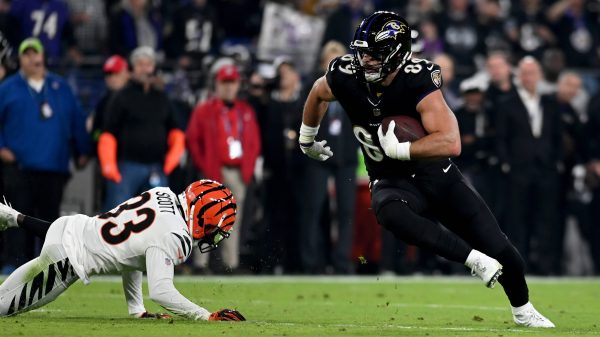Virtual reality (VR) has emerged as a groundbreaking technology that is revolutionizing various industries, including sports. In American football, VR has the potential to enhance the fan experience, improve training and coaching methods, transform broadcasting and media coverage, provide a new way for fans to experience games in stadiums, aid in research and development, and even change the way fans play American football games. But before delving into the potential of VR in American football, it is important to understand what virtual reality is and how it works.
Virtual reality is a computer-generated simulation that immerses users in a three-dimensional environment, allowing them to interact with and explore the virtual world. It typically involves the use of a headset or goggles that display the virtual environment, along with other peripherals such as motion controllers or haptic feedback devices that enable users to interact with the virtual world. The technology tracks the user’s movements and adjusts the virtual environment accordingly, creating a sense of presence and immersion.
The Potential of VR in Enhancing American Football Fan Experience
One of the most exciting aspects of VR in American football is its potential to provide a more immersive experience for fans. With VR, fans can feel like they are right on the field, experiencing the game from the perspective of players or coaches. They can see the action up close, hear the sounds of the game, and even feel the excitement of being in a stadium filled with cheering fans.
VR has already been used to enhance fan experience in other sports. For example, in basketball, NBA teams have started offering VR experiences that allow fans to sit courtside and watch games as if they were actually there. Similarly, in soccer, some clubs have used VR to provide fans with a 360-degree view of the stadium during matches.
The Integration of VR in American Football Training and Coaching
In addition to enhancing the fan experience, VR has the potential to revolutionize American football training and coaching methods. By using VR, players can simulate game situations and practice their skills in a safe and controlled environment. They can experience the speed and intensity of a real game without the risk of injury.
For example, quarterbacks can use VR to practice reading defenses and making split-second decisions. They can go through virtual game scenarios and learn how to make the right throws under pressure. Similarly, defensive players can use VR to improve their tackling technique and learn how to anticipate the movements of opposing players.
The Impact of VR on American Football Broadcasting and Media
Another area where VR is making a significant impact in American football is broadcasting and media coverage. With VR, fans can have a whole new way of watching games. They can choose their own camera angles, switch between different perspectives, and even rewind or pause the action to analyze plays.
Some broadcasters have already started experimenting with VR in American football. For example, during the 2018 Super Bowl, NBC Sports offered a VR experience that allowed fans to watch the game from multiple camera angles and get a 360-degree view of the stadium. This immersive experience gave fans a whole new perspective on the game and allowed them to feel like they were actually there.
The Future of American Football Stadiums in VR
In addition to enhancing the fan experience through broadcasting, VR also has the potential to transform the way fans experience games in stadiums. With VR, fans can have a virtual seat in the stadium and watch the game from any perspective they choose. They can feel like they are right on the sidelines or even in the huddle with the players.
Some sports stadiums have already started using VR to enhance the fan experience. For example, in soccer, some stadiums have installed VR booths where fans can put on a headset and get a virtual tour of the stadium or watch highlights from previous games. This allows fans to feel more connected to the team and the stadium, even if they are not physically present.
The Challenges and Limitations of VR in American Football
While the potential of VR in American football is exciting, there are also challenges and limitations that need to be addressed. One of the main challenges is the cost of VR technology. Currently, VR headsets and peripherals can be quite expensive, making it difficult for teams or individuals to afford them.
Another limitation of current VR technology is the resolution and image quality. While VR can provide an immersive experience, the graphics can sometimes be pixelated or blurry, which can detract from the overall experience. Additionally, some users may experience motion sickness or discomfort when using VR, especially if they are not accustomed to the technology.
The Role of VR in American Football Research and Development
Beyond training and coaching, VR also has a role to play in American football research and development. Coaches and researchers can use VR to test new plays and strategies in a virtual environment before implementing them on the field. This allows them to analyze different scenarios and make more informed decisions.
For example, coaches can use VR to simulate game situations and test different offensive or defensive strategies. They can see how players react to different plays and make adjustments accordingly. This can help teams gain a competitive edge by fine-tuning their game plans and maximizing their chances of success.
The Ethical and Social Implications of VR in American Football
As with any emerging technology, there are ethical and social implications that need to be considered when it comes to VR in American football. One potential concern is the potential for addiction to VR technology. With its immersive nature, some individuals may become overly reliant on VR and neglect other aspects of their lives.
Another concern is the impact of VR on the physical and mental health of players. While VR can be a valuable tool for training and coaching, it is important to ensure that it is used in a way that does not put players at risk of injury or harm. Additionally, the use of VR may have psychological effects on players, such as increased stress or anxiety.
The Future of American Football Gaming in VR
In addition to enhancing the fan experience and transforming training and coaching methods, VR also has the potential to change the way fans play American football games. With VR, fans can step into the shoes of their favorite players and experience the game from their perspective. They can throw passes, make tackles, and score touchdowns in a virtual environment.
Some sports gaming companies have already started exploring VR in other sports. For example, in soccer, there are VR games that allow players to take penalty kicks or participate in virtual tournaments. These games provide a more immersive and realistic experience for players and fans alike.
The Promising Future of American Football in Virtual Reality
In conclusion, virtual reality has the potential to revolutionize American football in various ways. From enhancing the fan experience to improving training and coaching methods, transforming broadcasting and media coverage, providing a new way for fans to experience games in stadiums, aiding in research and development, and changing the way fans play American football games, VR is poised to have a significant impact on the sport.
While there are challenges and limitations that need to be addressed, the future of American football in virtual reality looks promising. As technology continues to advance and become more affordable, we can expect to see even more innovative uses of VR in American football. Whether it’s watching games from the sidelines, practicing plays in a virtual environment, or playing American football games in VR, the possibilities are endless. Virtual reality is set to revolutionize American football and provide fans with an unprecedented level of immersion and engagement.
FAQs
What is American Football?
American Football is a sport played between two teams of eleven players on a rectangular field with goalposts at each end. The objective of the game is to score points by carrying or throwing the ball into the opposing team’s end zone.
What is Virtual Reality?
Virtual Reality (VR) is a computer-generated simulation of a three-dimensional environment that can be interacted with using specialized equipment such as a headset or gloves. It aims to create a realistic experience that simulates the user’s physical presence in a virtual world.
What is the Future of American Football in Virtual Reality?
The future of American Football in Virtual Reality is the potential development of American Football experiences in VR. This could include immersive simulations of games, training drills, and other football-related activities that allow users to experience the sport in a new and exciting way.
What are the Benefits of American Football in Virtual Reality?
The benefits of American Football in Virtual Reality include increased accessibility to the sport, improved training opportunities, and enhanced fan engagement. VR can also provide a safer environment for players to practice and develop their skills.
What are the Challenges of American Football in Virtual Reality?
The challenges of American Football in Virtual Reality include the cost of equipment, the need for specialized software and hardware, and the potential for motion sickness or other adverse effects. Additionally, the development of realistic simulations may require significant resources and expertise.
What are some Examples of American Football in Virtual Reality?
Some examples of American Football in Virtual Reality include VR training programs for players, immersive game simulations for fans, and interactive experiences that allow users to explore the sport in new ways. These experiences may be available through specialized VR platforms or as standalone applications.










































































































Recent Comments